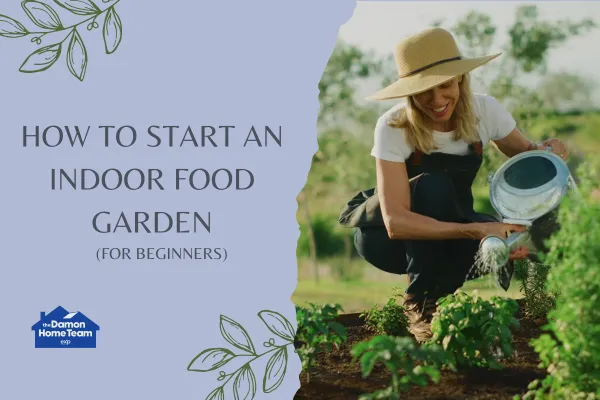
How to Start an Indoor Food Garden (for Beginners)
Picture this: fresh herbs for your pasta, crisp lettuce for your salads, and juicy tomatoes ripening on the vine—all within arm’s reach, right inside your home.
Starting an indoor food garden is a fun way to add fresh, homegrown flavor to your meals and bring a little greenery into your space while reducing your dependency on the grocery store (and those fluctuating prices!). Plus, it’s easier than you think! Here’s how to get started, even if you’ve never grown a thing in your life.

1. Choose the Right Spot
Plants need light, so the best place for your indoor garden is near a south- or west-facing window where they’ll get plenty of sun. If your home doesn’t have enough natural light, don’t worry—LED grow lights are a great alternative and can keep your plants thriving.
It’s also convenient (for you) and helpful (for your plants) to set your lights on a timer that mimics the natural rhythm of daylight. Smart plugs or built-in timers on grow lights can help automate the process.

2. Start with the Easiest Plants
Great beginner-friendly choices include:
Herbs: Basil, mint (in its own pot), parsley, thyme, oregano, and rosemary
Leafy Greens: Lettuce, spinach, arugula, Swiss chard, bok choy
Microgreens: Radish, kale, mustard—harvest in 10–14 days
Tomatoes and Peppers: Choose small varieties and give them deep containers
Root Vegetables: Carrots, radishes, and green onions in deeper pots
Strawberries: Use hanging baskets in bright areas

3. Pick the Right Containers
Containers should have proper drainage. Here's a quick guide:
Herbs/Microgreens: 4–6" deep
Leafy Greens: 6–8" deep
Tomatoes/Peppers: At least 12" deep, with support
Root Veggies: 8–12" deep
Strawberries: 6–8" deep, hanging or trailing
Avoid gravel at the bottom—use high-quality potting soil instead for proper water movement.

4. Use Quality Soil and Fertilizer
Use organic potting mix, not outdoor soil. Fertilizer tips:
Herbs/Leafy Greens/Microgreens: Every 2–4 weeks (or not at all)
Fruiting Plants: Every 2 weeks during flowering
Root Veggies: Monthly with balanced fertilizer
Always water before fertilizing to avoid root burn.

5. Water Smartly
Overwatering is a common mistake. Check if the top inch of soil is dry before watering. Self-watering planters and trays can help regulate moisture and protect surfaces.
6. Give Them Some TLC
Check plants regularly. Rotate them for even growth, prune herbs, and monitor for pests. For gnats, try cinnamon on the soil or a mild soap spray.
7. Enjoy the Rewards!
From fresh basil to crunchy lettuce, there's nothing like harvesting your own food. Indoor gardening is also a great stress reliever and adds beauty to your home.
Need more space for your indoor garden?
Let’s find you the perfect home that fits your indoor (and outdoor!) gardening dreams.
Visit damonhometeam.com for more information!












